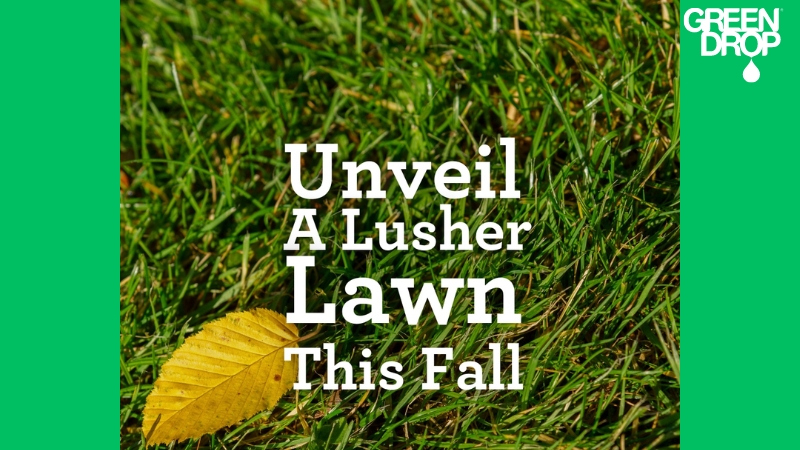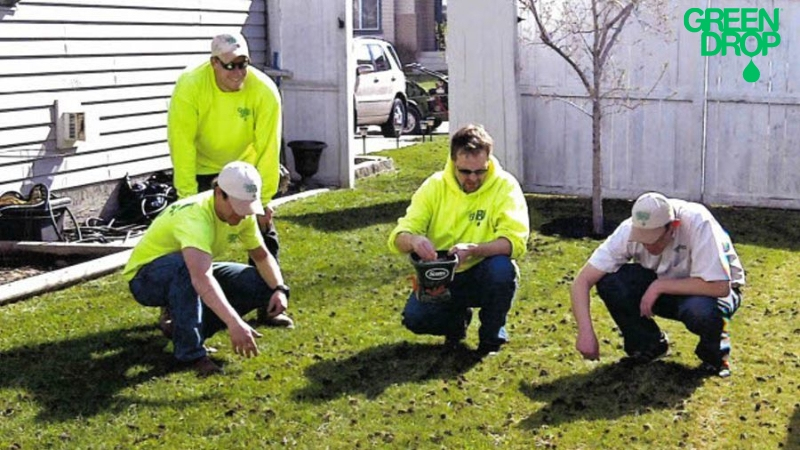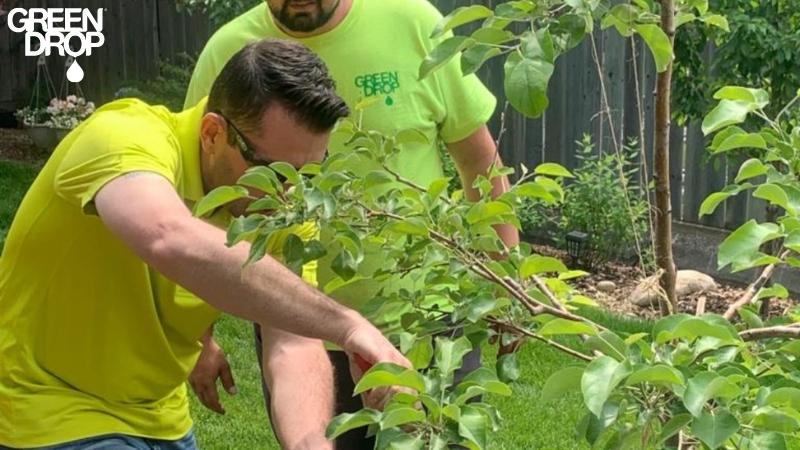Falling into Autumn - A Fall Lawn Checklist For What to Do Before the First Frost
Reading time: 8 minutesFalling into Autumn - A Fall Lawn Checklist For What to Do Before the First Frost
As the days get shorter and the air gets crisper, it’s time to start thinking about; one, how to make sure your lawn stays healthy in the Fall and prepping your lawn for the first frost. You don't want to be caught off guard or under-prepared when those sub-zero temperatures hit.
Good thing we’ve got you covered with our pre-frost checklist that’ll make sure your yard is as ready for winter as you are for a cozy night by the fire.

Fall Lawn Prep Checklist
1. Clean Up the Garden Beds
As autumn rolls in, it's time to give your garden beds a proper clean-up to prepare for the first frost. Start by removing dead plants and debris. Leaving them in your garden can attract pests and diseases, which you definitely don't want to stick around through the winter.
Pruning perennials is another essential task. Cutting back these hardy plants to tidy up your garden encourages healthier growth come spring. Be sure to snip away any dead or diseased parts but leave enough foliage to protect the plant during the colder months.
Don't forget about your annuals. If they’re looking worse for wear, it’s time to pull them out and toss them into the compost pile. This helps keep your garden looking neat and prevents any diseases from lingering in the soil.
2. Rake and Mulch Leaves
As the leaves start to fall, it’s time to grab your rake and get to work. While the sight of colourful leaves blanketing your lawn can be picturesque, leaving them there can actually affect your grass. Thick layers of leaves can smother your lawn, block sunlight, and trap moisture, creating a breeding ground for mould and disease. So, let’s get those leaves cleaned up, shall we?
Raking leaves is a classic autumn activity – think of it as a great way to enjoy the crisp fall air and get some exercise. Make sure to gather up all the leaves from your lawn, garden beds, and walkways. Once you’ve got a good pile, don’t just toss them away (they can be put to good use).
Mulching leaves is an excellent way to recycle and provide your garden with a nutrient-rich blanket for the winter. Use a mulching mower or a leaf shredder to chop the leaves into smaller pieces. These mulched leaves can then be spread over your garden beds as a protective layer. If it’s not too thick, you can leave them on the lawn. Either way, they’ll decompose over time and create a rich compost.
3. Aerate, Then Overseed Your Lawn

Aeration and overseeding are great to do in the fall and before the first frost. The soil tends to become compacted, making it difficult for water, nutrients, and oxygen to reach the grassroots.
Aeration involves perforating the soil with small holes to allow these essential elements to penetrate deeper into the ground. Aerating helps break up thatch, improves soil structure, and promotes stronger root growth.
Once you’ve aerated, it’s a great time to overseed. Overseeding involves spreading grass seed over your existing lawn to fill in bare spots and thicken the turf. Choose a grass seed that’s suited to your climate and lawn conditions. This will help your lawn recover from summer and prepare for the cooler months ahead. We need to spread the seed evenly all over your lawn, paying special attention to thin or bare areas.
4. Fertilize the Lawn
Fertilizing your lawn in the fall helps grass build strong roots and store essential nutrients for the winter. The cooler temperatures and increased moisture create ideal conditions for the grass to absorb the fertilizer effectively. This late-season feeding supports root development, giving your lawn a head start when growth resumes in the spring.
We recommend a slow-release fertilizer with a balanced mix of nutrients, focusing on nitrogen, phosphorus, and potassium. Nitrogen promotes healthy leaf growth, phosphorus strengthens roots, and potassium enhances overall plant health and resistance to disease. Look for a fall-specific fertilizer blend to ensure your lawn gets the right nutrients it needs during this critical period.
Our SoilBooster™ is the ideal solution. This nutrient-packed formula gives your lawn exactly what it needs to power through winter and thrive all year long.
5. Trim and Prune Shrubs

Fall is the ideal season for trimming and pruning, helping to keep your plants healthy and well-shaped throughout the winter and into the next growing season.
Pruning in the fall helps remove dead or diseased plants, preventing potential damage during winter storms. It also encourages healthier growth in the spring by allowing sunlight and air to reach the inner parts of the plants.
Focus on removing dead, damaged, or shrubs first. Next, trim back any branches that are crossing or rubbing against each other, as they can cause wounds that invite pests and diseases. Finally, shape the plant by cutting back any overly long branches to maintain a tidy appearance. If this is too complicated, you can always give us a call for pruning. Or get a free assessment from our ISA-certified arborist. They always know what’s best for your trees & shrubs.
6. Protect Delicate Plants
When the temperature drops, your delicate plants need a little extra care to survive the winter frost.
- Cover Sensitive Plants. For plants that are particularly vulnerable to frost, such as tender perennials and young shrubs, use frost covers or old blankets to keep them warm. Covering these plants helps trap heat from the soil, providing a protective barrier against the cold.
- Move Potted Plants Indoors. If you have plants in pots, bring them inside before the first frost hits. Indoor temperatures are much more stable and can protect these plants from harsh outdoor conditions. Place them near windows where they can get ample sunlight but away from draughty areas or heat sources like radiators.
- Use Mulch or Straw. Insulate the roots of your delicate plants by applying a thick layer of mulch or straw around their bases. Mulch acts as a blanket, keeping the soil temperature more consistent and preventing roots from freezing. It also helps retain moisture, which is crucial during the dry winter months.
- Cloche Protection. For smaller plants and seedlings, consider using cloches. These are bell-shaped covers that provide individual protection to plants. They are especially effective in trapping heat and shielding plants from frost.
- Erect Wind Barriers. You may need to use burlap, canvas, or other breathable materials to protect sensitive plants from harsh winds, which can cause desiccation and increase frost damage. Place stakes around the plants and attach the material to create a sheltered environment.
7. Winterize the Irrigation System

Water left in the pipes can freeze, expand, and cause the pipes to crack or burst, so it’s important to winterize your irrigation system. Start by turning off the water supply to the system. Then, drain the water from the pipes by opening all the valves and allowing the water to flow out. For systems with automatic timers, make sure to shut off the controller and remove any batteries to avoid damage from freezing temperatures.
One of the most effective ways to winterize your irrigation system is by blowing out the pipes with compressed air. This expels all the water from the system, preventing any potential freeze damage. It’s important to do this carefully to avoid damaging the pipes and components. If you’re unsure how to do this, consider hiring a professional to ensure your system is properly winterized and ready for spring.
8. Check for Pests and Diseases
Autumn is the perfect time to catch any lingering issues that could carry over into the next growing season. Look for signs of pests like aphids, spider mites, and beetles on plants and in the soil. Also, check for fungal diseases such as powdery mildew or rust.
To manage these problems, remove any affected leaves or plants and consider using organic treatments to prevent spread. Clean up fallen leaves and debris where pests can hide and overwinter. Regular monitoring and early intervention can significantly reduce pest and disease issues in spring.
9. Stop Watering
This last item of our checklist isn’t really something you have to do; rather, what you have to stop doing, and that’s watering. It can be tempting to keep working on your lawn, but it's essential to recognize when it's time to let your lawn rest and recuperate.
Continuing lawn care too far into the late Fall months can cause more harm than good. Overworking your lawn can lead to damage that may not be apparent until spring, such as unexpected browning patches. You don’t want to be surprised by a less-than-healthy lawn when the growing season begins.
While regular lawn care is crucial for maintaining a healthy yard, it's just as important to give your lawn a break. If you've followed all the necessary steps for fall lawn care, trust that your efforts will pay off. By allowing your lawn to rest, you'll help ensure it comes back stronger and more vibrant in the next growing season.
Don’t forget to check out our blog on Fall Lawn Care Mistakes to Avoid.

Let Us Handle Your Lawn's Last Pampering Before the Cold
Ready to give your lawn the care it deserves? Book your Fall package now and see how Green Drop can make your fall preparations a breeze. We proudly serve Calgary, Red Deer, Winnipeg, Regina, Saskatoon, and Edmonton.

